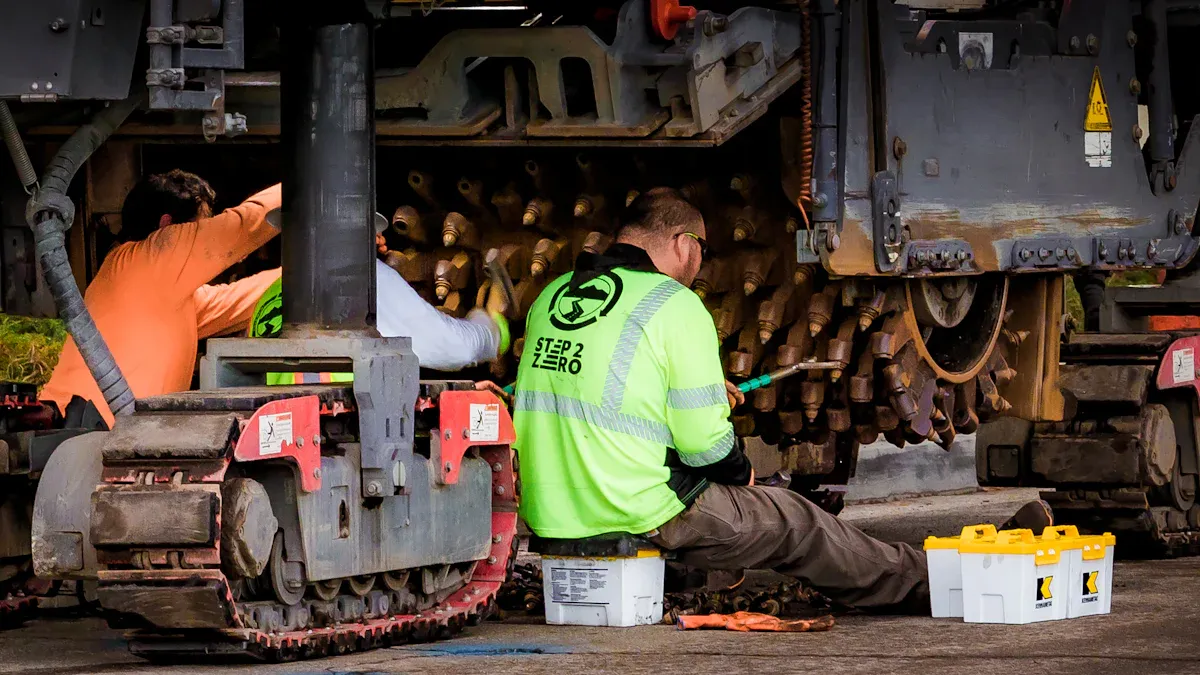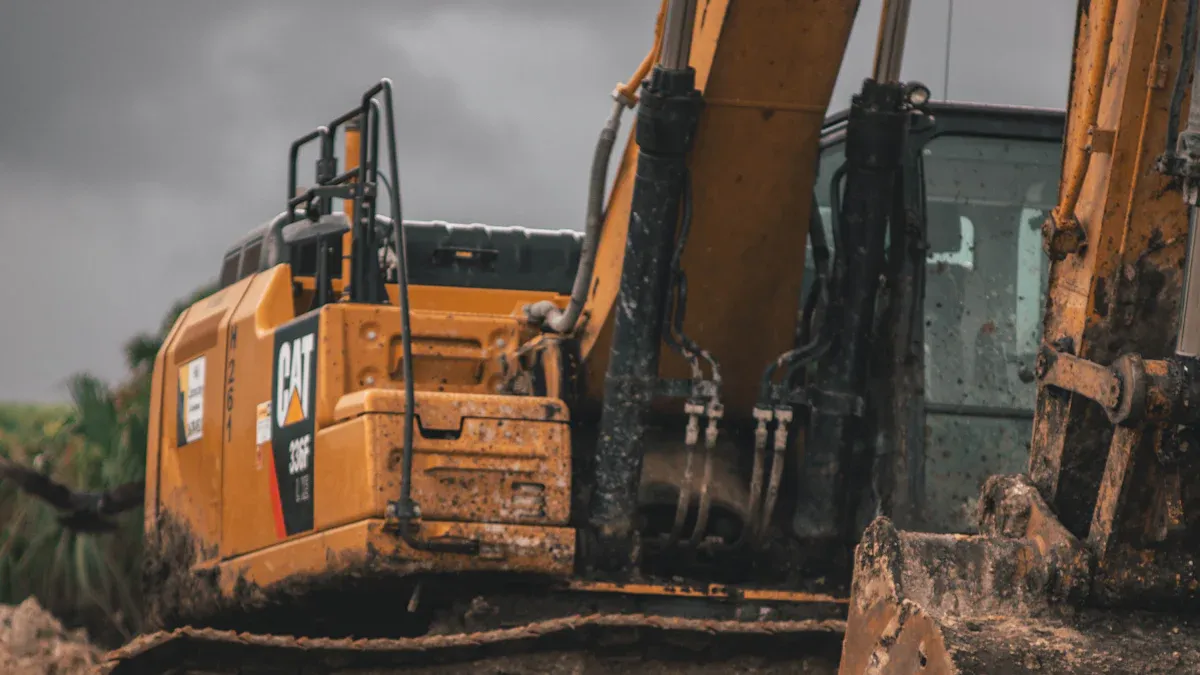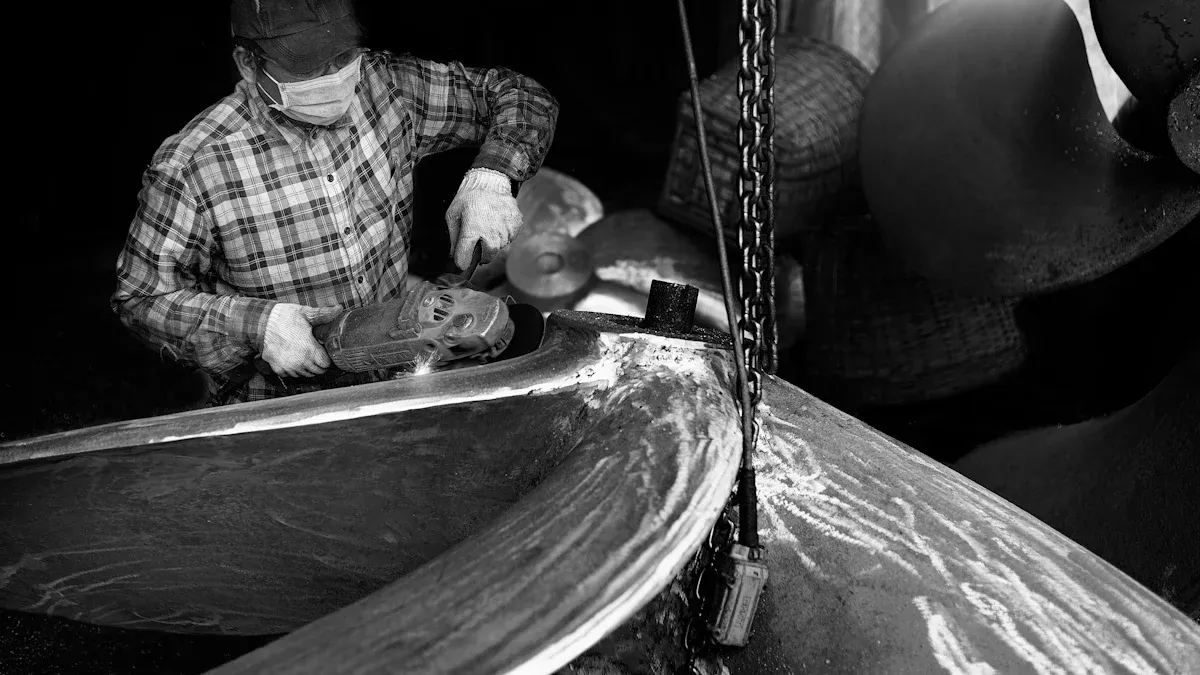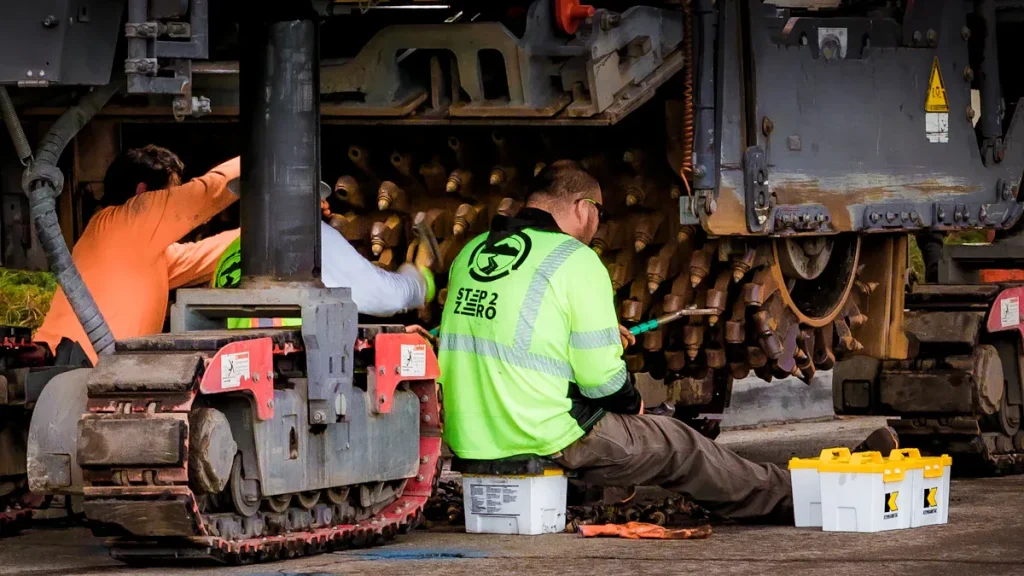
Maintaining your excavator’s bucket in top condition is essential for efficient operations and long-term savings. Regular repair work ensures optimal performance, faster project completion, and reduced downtime. It also prevents costly breakdowns and extends the equipment’s lifespan. Using high-quality materials and tools during repairs guarantees durability and safety, which are critical for consistent performance. For reliable excavator bucket repair parts, YNF Machinery offers a trusted solution. Their extensive range of products ensures you have access to the components needed to keep your equipment running smoothly.
Key Takeaways
Check your excavator bucket often for cracks or thin spots. Finding problems early can stop expensive fixes later.
Think about damage, material, and cost when fixing or replacing. Smart choices can save you money over time.
Use strong materials like AR400 steel and hard-facing rods. These make the bucket last longer and resist damage.
Heat the bucket before welding to avoid cracks. Pick the right welding method to make strong repairs.
Work with trusted suppliers like YNF Machinery for good parts. Their quality parts improve work and reduce delays.
Repair or Replace: Making the Right Decision
Assessing the Damage
Before deciding whether to repair or replace your excavator bucket, you need to evaluate the extent of damage. Look for signs of wear, such as cracks, dents, or thinning metal. Minor issues like surface abrasions or small cracks can often be fixed with proper repair techniques. However, severe structural damage or extensive corrosion may compromise the bucket’s integrity, making replacement a safer option. Regular inspections in the field can help you identify problems early, reducing the risk of costly downtime.
Factors to Consider When Deciding
When choosing between repairing or replacing, several critical factors come into play. These include:
Maker Reputation
Material Quality
Compatibility
Warranty And Support
Certifications
Supplier’s Credibility
Cost vs Quality Balance
Additionally, the availability of replacement parts can influence your decision. If parts for your bucket are hard to find, repair might be the more practical choice. On the other hand, if the cost consideration leans heavily toward replacement due to excessive repair expenses, replacing the bucket could save you money in the long run. Always weigh these factors carefully to make an informed decision.
Benefits of Repairing with YNF Machinery’s Excavator Bucket Repair Parts
Repairing your bucket with YNF Machinery’s excavator bucket repair parts offers several advantages. Their high-quality components ensure durability and reliability, even under demanding conditions. Using second-hand materials from YNF Machinery can significantly reduce repair costs, making it a cost-efficient option. Their wide availability of used parts for older models minimizes downtime, enhancing overall performance. Moreover, opting for used components supports recycling, which is environmentally friendly. YNF Machinery ensures that all parts meet strict quality standards, so you can trust them to perform reliably in the field.
By choosing YNF Machinery, you gain access to a trusted supplier with over 35 years of experience. Their commitment to quality and customer satisfaction makes them an excellent partner for maintaining your excavator’s efficiency.
Materials and Tools for Effective Repairs

Essential Materials for Bucket Repairs
Types of Steel (e.g., AR plates, ASTM A572 Grade 50)
Choosing the right steel is crucial for repairing worn areas of your bucket. High-quality steel ensures durability and resistance to wear. Some of the most effective options include:
AISI 4130 and AISI 4140: These chromium molybdenum steels enhance corrosion resistance and provide exceptional strength.
AR360 and AR400: Heat-treated steels known for their abrasion resistance and impact strength. AR400, in particular, offers superior yield strength, making it ideal for high-stress areas.
ASTM A572 Grade 50: A high-strength, low-alloy steel that balances toughness and weight. It works well for bucket shells due to its excellent strength-to-weight ratio.
Using these materials ensures your repairs can withstand heavy usage and extend the life of your excavator bucket.
Welding Rods and Filler Materials
Welding rods and filler materials play a vital role in reinforcing damaged areas. For hard facing applications, you should use hard facing rods designed to resist wear and abrasion. These rods create a protective layer on the surface, reducing future wear. Additionally, select filler materials compatible with the steel type to ensure a strong bond and long-lasting repair.
Tools You’ll Need
Welding Machines and Grinders
A reliable welding machine is essential for applying hard facing and repairing cracks. Choose a machine that supports various welding methods, such as MIG or TIG, to match your repair needs. Grinders are equally important for smoothing welds and preparing surfaces for hard facing. High-quality tools ensure precision and efficiency during repairs.
Safety Equipment and Accessories
Safety should always come first. Equip yourself with protective gear, including welding helmets, gloves, and flame-resistant clothing. Use safety glasses and ear protection when grinding or welding. These accessories protect you from sparks, heat, and debris, ensuring a safe repair process.
Why Choose YNF Machinery for Hydraulic Cylinder Seal Kits
YNF Machinery offers high-quality hydraulic cylinder seal kits that prevent oil leaks and maintain smooth operation. These kits are crafted from durable materials like NBR and FKM, ensuring flexibility and strength. Their precise manufacturing guarantees a perfect fit, reducing the risk of misalignment. By choosing YNF Machinery, you gain access to reliable products that enhance the efficiency and longevity of your excavator.
Step-by-Step Guide to Repairing Excavator Buckets

Preparation
Inspecting the Bucket for Damage
Start by thoroughly inspecting your bucket to identify areas that need attention. Look for cracks, thinning metal, or signs of excessive wear. Pay close attention to high-stress areas like the edges and corners. Use a flashlight to examine hard-to-see spots. Document the damage to plan your repair process effectively. Early detection of issues can prevent further deterioration and save you time during bucket repairs.
Cleaning and Removing Debris or Rust
Before you begin repairs, clean the bucket to remove dirt, debris, and rust. Use a wire brush or grinder to scrape off rust and ensure a smooth surface. For stubborn rust, apply a rust remover and let it sit for a few minutes before scrubbing. Cleaning ensures that your welds adhere properly and last longer. A clean surface also helps you see the damaged areas more clearly, making the repair process more efficient.
Welding Techniques
Preheating and Choosing the Right Welding Method
Preheating the bucket before welding is crucial, especially when working with high-strength steel. Use a propane torch to heat the area around the damage. This reduces the risk of cracking and ensures a stronger weld. Choose a welding method that suits the material and type of damage. MIG welding works well for general repairs, while TIG welding offers precision for smaller cracks. Stick welding is ideal for heavy-duty applications like adding wear bars.
Applying Welds to Damaged Areas
Once preheated, apply welds to the damaged sections. Start with short welds to minimize heat distortion. Use hard-facing rods to reinforce areas prone to wear. For cracks, begin welding from the center and move outward to prevent further spreading. If you need to weld on wear bars, position them carefully and secure them with clamps before welding. Ensure each weld is smooth and free of gaps to maintain the bucket’s structural integrity.
Finishing Touches
Grinding and Smoothing Welds
After welding, use a grinder to smooth out the welds. This step removes excess material and ensures a uniform surface. Smooth welds reduce stress points and improve the bucket’s durability. Take your time to grind evenly, focusing on high-wear areas to enhance their resistance.
Applying Protective Coatings for Durability
To extend the life of your bucket, apply a protective coating after repairs. Use a rust-resistant primer followed by a durable paint designed for heavy machinery. This coating shields the bucket from corrosion and wear, keeping it in top condition for longer. Regular maintenance of the coating will further enhance the bucket’s lifespan.
Tip: Always follow the manufacturer’s guidelines for welding and coating materials to ensure optimal results.
Common Challenges and Troubleshooting Tips
Welding AR Plates and Abrasion-Resistant Steel
Welding AR plates and abrasion-resistant steel can be tricky. These materials are designed to withstand wear, making them harder to weld. You need to preheat the steel to reduce the risk of cracking. Use a propane torch to heat the area evenly before starting. Select a welding rod compatible with the steel type to ensure a strong bond. Stick welding often works best for these materials due to its ability to handle high-stress applications. Avoid overheating, as it can weaken the steel and reduce its abrasion resistance. After welding, inspect the area for cracks or gaps to ensure the repair holds up under heavy use.
Ensuring Durability and Preventing Future Wear
Durability starts with proper maintenance. Clean your bucket after every use to remove debris and mud. This simple step prevents corrosion and extends the life of your repairs. Apply a protective coating to shield the bucket from rust and abrasion. Regularly inspect high-wear areas like edges and corners. Reinforce these spots with wear bars or hard-facing rods during repairs. Use high-quality materials, such as AR400 steel, to handle tough conditions. These practices ensure your bucket stays in good shape, even in demanding field operations.
Tips for Preventing Wear:
Clean the bucket thoroughly after each use.
Apply rust-resistant coatings regularly.
Inspect and reinforce high-stress areas.
How YNF Machinery’s Excavator Bucket Repair Parts Can Help
YNF Machinery provides reliable solutions for your excavator bucket repairs. Their repair parts meet strict quality standards, ensuring durability and performance. You can find components like wear bars, hard-facing rods, and hydraulic cylinder seal kits. These parts are designed to handle abrasion and heavy-duty use. YNF Machinery’s extensive inventory ensures you get the right part for your bucket, reducing downtime. Their products help you maintain efficiency in the field while saving costs. With over 35 years of experience, YNF Machinery is a trusted partner for excavator owners worldwide.
Pro Tip: Always choose high-quality repair parts to maximize the lifespan of your bucket and reduce future maintenance costs.
Effective bucket repairs play a vital role in maintaining your excavator’s performance and reducing costs. By using high-quality materials and following proper repair techniques, you ensure durability and long-term efficiency. Partnering with trusted suppliers like YNF Machinery guarantees access to reliable parts that meet your needs.
Apply these methods to extend the life of your equipment and achieve consistent results. Regular maintenance and timely repairs will keep your excavator operating at its best, saving you time and money in the long run.
FAQ
What are the signs that my excavator bucket needs repair?
Look for cracks, thinning metal, or worn edges. Check for loose or missing wear bars and excessive rust. Regular inspections help you catch these issues early, preventing further damage.
How often should I inspect my excavator bucket?
Inspect your bucket after every 50-100 hours of operation. Frequent checks ensure you identify wear and tear before it leads to costly repairs or downtime.
Can I use any welding rod for bucket repairs?
No, you should use welding rods compatible with the bucket’s steel type. Hard-facing rods work best for wear-prone areas, while general-purpose rods suit minor repairs.
Why is preheating necessary before welding?
Preheating reduces the risk of cracking and ensures a stronger weld. It helps the metal expand evenly, improving the bond between the weld and the base material.
How does YNF Machinery support bucket repairs?
YNF Machinery offers high-quality repair parts like wear bars and hydraulic cylinder seal kits. Their products meet strict quality standards, ensuring durability and reliable performance.
Tip: Always use high-quality materials and tools for repairs to maximize your bucket’s lifespan.





